Once your house design has been finalised and a preliminary costing-estimate has been completed it is time to lodge your plans into council. Before you start producing detailed plans try our free construction cost calculator (this will reduce the chance of serious cost overruns). Once you have reasonably detailed plans we recommend you talk to a quantity surveyor or licenced builder for more accurate costing estimates.
DA (Development Application)
A DA (Development Application) is the first part of the council approval process. The DA is typically submitted by the developer or owner to the local council for approval of new homes and renovations that involve structural changes. Design drawings, Statement of Environmental Effects, Materials Reuse Statement (also called a Waste Management Report) and a BASIX Certificates (or equivalent, depending on your state) must accompany the application. Other reports such as Flora and Fauna Assessments, Bushfire Assessments and Geo-technical Assessments may also be required (you need to check with your local council). Together these documents describe the usage, style, size and location of the intended building and its surrounds including the zoning and any special conditions that may be placed upon the property.
Those special conditions or encumbrances are listed in the Section 149 Certificate that form part of the contract of sale document. They can include:
- bushfire areas
- earthquake of subsistence areas
- alpine environments
- waterways
- heritage
- flood zone
These encumbrances can limit your choose of construction types eg, rendered brick walls are not suggested in mine subsidence areas due to the cracking that will most likey occur as a result of ground movement. For the same reasons, unusual structures such as strawbale buildings will need special consideration.
A DA approval is required for a new building and for alterations to an existing building when there is a:
- change in the footprint of the building
- change to the facade ie location of windows and doors and roof line
- structural change ie structural beam added
- alteration to the location of services.
Once the council is satisfied that the development is in accordance with council requirements and that it blends in with the surrounding building, approval is granted and remains valid for 5 years (Oct 2010).
It should be noted that many alterations to buildings are made without DAs. Often the only record of the interior of an existing building is the plumbing diagram, which shows the building footprint and services. It is in fact possible to completely refurbish a house without a DA. Keep in mind that a DA will be required if you are changing the structure or window and door locations on a building.
Currently councils take on average 78 days to assess a new development and 57 days to assess an alternation.
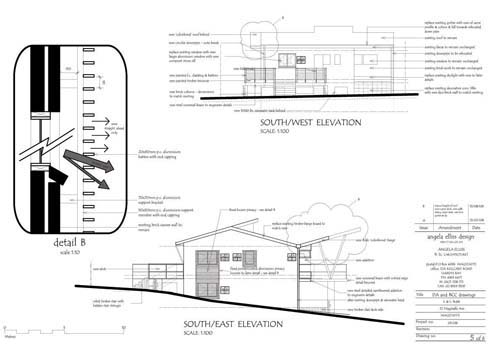
Tip: Move your mouse or finger over the images to magnify
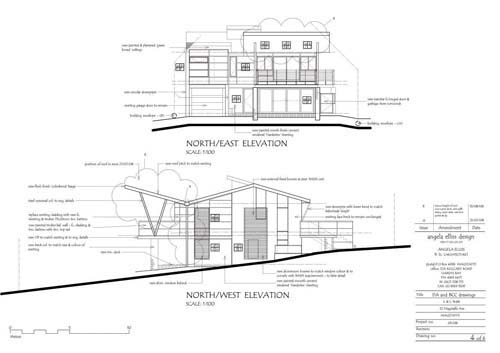
BCC (Building Construction Certificate)
A Building Construction Certificate application is the second part of the council approval process and a Building Construction Certificate will need to be issued by the local council before a development can begin - this includes any clearing that is required before construction. (Councils in other states are likely to have similar approvals.) The building's Design/Construction Drawings and Specification document is submitted to council and reviewed by a Building Surveyor who confirms that all construction types noted on the plans are compliant with building codes and regulations and minimum standards of quality have been adhered to. (See below for more information about these drawings.)
A combined DA and BCC application can be submitted to council, which is cheaper, unless the construction is complicated.
Changes after a BCC has been issued must be approved by council, during construction, may cause non compliance, and require a Section 96 amendment application.
Different documents and drawings may be required at different stages of building. For a selection of sample documents see Gosford Council building forms by clicking here.
New Preset Housing Codes
Preset housing codes will be introduced into NSW in Dec 08 and become operational on Feb 17, 2009. There will be a series of codes for different house types and lot sizes, and for small commercial developments. This new code will reduce approvals to 10 days. It will cover suburbs in Sydney's middle and outer ring where house blocks are larger than 450 square meters but would not cover small inner city bocks. The details of the code have yet to be released.
Site Survey
This is a graphic description of the property and a comprehensive survey usually contains:
- North arrow and scale of drawing
- Location of public thoroughfares
- Site boundary dimensions
- Location of easements
- Location of existing developments and driveways
- Contour lines in AHD levels
- Locations of trees
- Location of fencing and sheds
- Location of watercourses, services, rock outcrops etc
From this a Site Plan and Analysis is created. See example at the DIY Home Design website.
This document may include more or less information than the above and is essential in informing councils assessors and neighbours about the proposed development. It is also a valuable document when considering future site improvements. A detailed survey will cost around $1,000.
See the article How to Read Plans for more information on site plans.
BASIX Report
BASIX is the acronym for "Building Sustainability Index". Since October 2006 all development applications lodged in NSW for new homes, renovations and additions valued over $100,000 must contain a BASIX certificate. Applications for installing a pool or spa must also include a BASIX certificate. The BASIX certificate pledges the homeowner to water and energy saving commitments that must be verified by an accredited certifier before an Occupation Certificate is issued.
For more information see our article on Council Reports.
Materials Reuse Statement (sometimes called Waste Management Report)
This is a short 2 page form where the applicant makes a statement to local council how demolished materials will be disposed of, or recycled, and how waste will be managed during construction.
Geotechnical Report
The type of soil determines the bearing capacity (how much weight it can support), and its reactivity (how much the soil moves with different moisture contents).
This report or assessment by a geo-technical engineer is normally requested by the architect or structural engineer. The engineer inspects the site and if necessary, takes soil samples from the site and analyses them in a soil lab. The information in his report allows the engineer to nominate the type of footings required. This assessment will cost around $3,000
Flora and Fauna Assessments
This report is typically required if your site is part of a bushland area. Council will require this report to assess the development and its likely impact on any endangered flora and Fauna. This report may request that no development is to occur in particular areas of the site and will also cost around $3,000
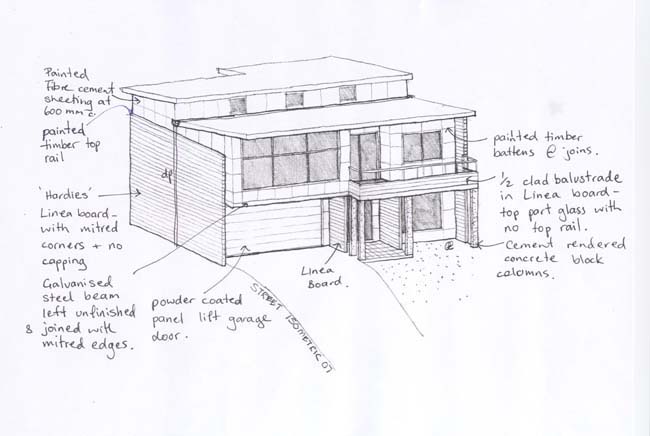
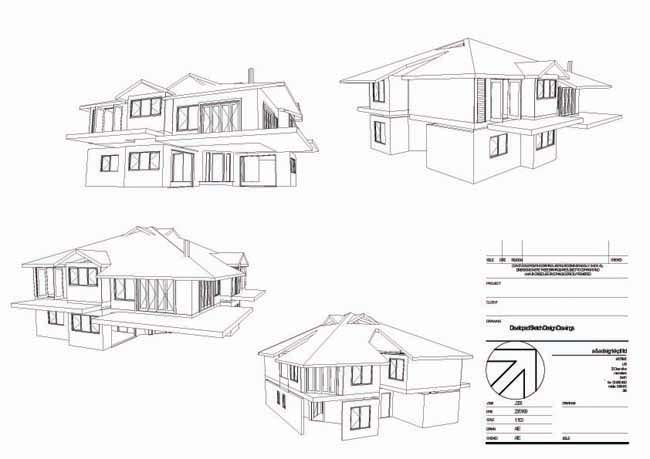
Design Drawings
The architect/building designer or drafts person (designer) starts by drawing some rough sketches which are presented to the client for discussion. Those sketches might be revised a few times until the client is happy. The designer then draws up accurate and complete design drawings for the client and for council approval. They will include plans, elevations and sectional views and may also include a model, three dimensional drawings and detailed drawings. The fees for these drawings will vary greatly depending on the designers qualifications & experience see our FAQ for more information.
Construction (Building) Drawings
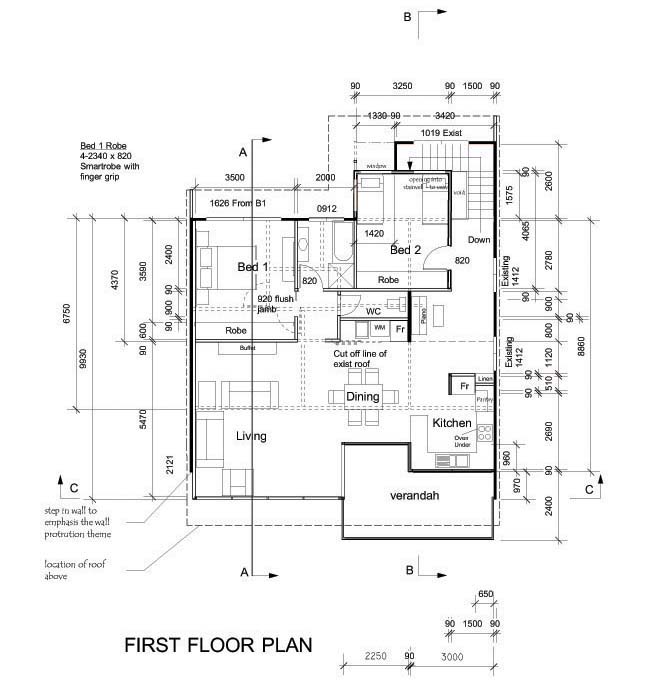
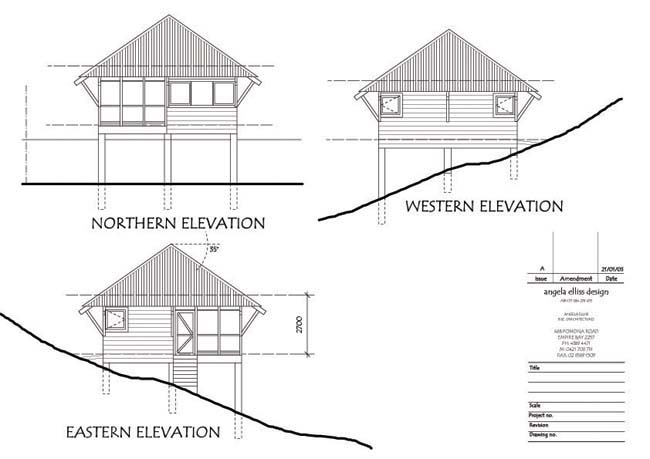
These are filled-out and finalised design drawings of the building that show all sufficient detail to allow the builder or tradesman to construct the building. They will include to scale floor plans that also show front and side elevation, and sections. These drawings will also explain:
- Details of wall dimensions, construction and cladding types
- Heights of balconies and their wall or screen materials
- Roof construction and pitches and cladding details
- Distance of development from site boundaries
- What type of windows and doors are to be used and where they are to be located
Other drawings (will cost extra)
- Service diagrams (electrical and plumbing etc)
- Engineering details for footings and slabs for example
- Wet area details showing bath, toilet and sink locations
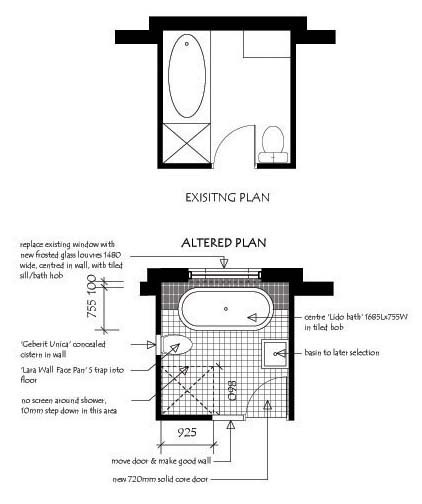
Initial design for bathroom
Project Specifications or "Spes"
The "spes" is a working document usually drawn up by the designer - a standard and basic Spes can be purchased from associations such as the RAIA or MBA and can sometimes be purchased at your local council for around $20.
The designers spes is a complete and comprehensive description of various aspects of the building project and includes such things as:
- Site Preparation
- Concrete Construction
- Timber and Steel Construction
- Brick and Block Construction
- Insulation and sarking
- Roofing
- Cladding
- Doors and Window
- Lining
- Trowelled Coatings
- Block and tile Finishes
- Floor Coating and Coverings
- Painting
- Timber Fixtures
- Plumbing and Drainage
- Electrical and Mechanical Installations
- Fences and External walls
- Landscaping
- Pavement and Roads
The Spes is included in the BCC to ensure that the construction and its finishes meet the minimum Australian Standard of quality. This information may also be required by a lending authority.
Detailed specifications also include information about:
- Floor finishes
- Wall finishes
- Size and types of window frames and hardware
- Types of doors and door hardware
- Type of kitchen cabinetry, hardware and white goods
- Type of bathroom cabinetry, shower recesses, baths and hardware
- Style and number of lights
The Specification defines the type of finishes (budget, average or luxury) of the construction. The type of finish can dramatically change building costs, so without this detail it is not possible to cost the finishing of the building. The Spes is also an important guide for tradespeople for it defines the quality and extent of work required and the PC items that need to be acquired by the tradesperson or the owner.
Click the following link to see an example specification.
Electronic specifications can be purchased from such companies as Natspec or Speedspec but cost around $350 per year; they are made for professionals that regularly prepare specifications.
Tendering
If you do not have a builder in mind or if you want to compare prices you can put your job out for tender. This involves getting together all the above mentioned documents as well as the DA conditions and sending them to usually 3 builders. There is a great deal of time and effort that the chosen builders put into tendering so only go through this process if you are serious and ready to build. Set a tender submission date - this reduces the likleyhood of the tender process dragging on for too long.
Remember that there is more than the price that needs to be considered when selecting a building - see: How to Read a Builder's Quote.
Building Contracts
There are a few to choose from and they are usually purchased by the builder from such associations as:
- Department of fair trading
- Master Builders Association
- Royal Australian Institute of Architects
There are various types of contracts:
- Small and large residential works - fixed or cost plus (no fixed price)
- Small and large comercial works - fixed or cost plus
The contract is signed by the builder and the client only.
